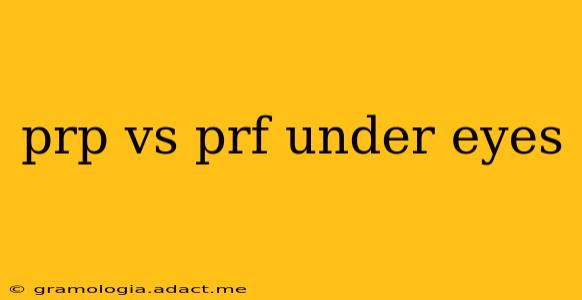The delicate skin under the eyes is prone to showing signs of aging, including wrinkles, dark circles, and hollowness. Platelet-rich plasma (PRP) and platelet-rich fibrin (PRF) are two innovative treatments gaining popularity for rejuvenating this sensitive area. Both utilize your own blood to stimulate collagen production and improve skin quality, but they differ in their preparation and potential benefits. This article will delve into the key differences between PRP and PRF for under-eye rejuvenation, helping you determine which treatment might be the best option for your individual needs.
What is PRP?
PRP, or platelet-rich plasma, involves drawing a small amount of your blood, spinning it in a centrifuge to separate the platelets, and then injecting the concentrated platelet-rich plasma back into the treatment area. Platelets are rich in growth factors, proteins that stimulate cell regeneration and collagen production. This process aims to revitalize the skin, reducing the appearance of wrinkles, fine lines, and dark circles.
What is PRF?
PRF, or platelet-rich fibrin, is a similar autologous therapy (using your own body's resources) but differs significantly in its preparation. Instead of using a centrifuge at high speeds to separate platelets, PRF uses a lower-speed centrifugation. This results in a fibrin matrix that encapsulates the platelets and other growth factors. This matrix acts as a scaffold, providing a sustained release of growth factors over a longer period. This sustained release is often cited as a key advantage over PRP.
PRP vs. PRF: Key Differences
| Feature | PRP | PRF |
|---|---|---|
| Preparation | High-speed centrifugation | Low-speed centrifugation |
| Growth Factor Release | Faster, initial burst | Slower, sustained release over time |
| Fibrin Matrix | Minimal fibrin matrix | Abundant fibrin matrix, acts as a scaffold |
| Cost | Generally less expensive | Generally more expensive |
| Treatment Time | Potentially shorter treatment sessions | Potentially longer treatment sessions |
What are the benefits of PRP under the eyes?
PRP under-eye treatment aims to:
- Reduce the appearance of wrinkles and fine lines: By stimulating collagen production, PRP can help to plump up the skin and reduce the visibility of wrinkles.
- Improve skin texture and tone: The growth factors in PRP can improve skin elasticity and reduce the appearance of pores.
- Lighten dark circles: PRP can help improve blood circulation in the area, reducing the appearance of dark circles under the eyes.
What are the benefits of PRF under the eyes?
PRF offers similar benefits to PRP but with the potential for:
- Longer-lasting results: The sustained release of growth factors from the fibrin matrix may lead to longer-lasting improvements in skin texture and tone.
- Improved tissue regeneration: The fibrin matrix acts as a scaffold for tissue repair, potentially leading to more significant improvements in skin quality.
- Reduced inflammation: The fibrin matrix has anti-inflammatory properties, which can be beneficial for reducing swelling and inflammation in the under-eye area.
Which is better, PRP or PRF for under-eye treatment?
There's no single "better" treatment; the ideal choice depends on individual factors such as the extent of under-eye concerns, budget, and personal preferences. A consultation with a qualified medical professional specializing in aesthetic treatments is crucial. They can assess your specific needs and recommend the treatment best suited for you.
How long do the results last?
The longevity of results for both PRP and PRF under-eye treatments varies depending on factors like individual skin type, age, lifestyle, and sun exposure. Generally, you can expect to see improvements lasting several months, and multiple treatments may be recommended for optimal and long-lasting results.
Are there any side effects?
Side effects are generally minimal and temporary, including mild swelling, bruising, or redness at the injection site. These typically resolve within a few days.
Is PRP or PRF right for me?
This decision is best made after a thorough consultation with a qualified dermatologist or plastic surgeon. They can evaluate your specific needs and recommend the most appropriate treatment plan. Discuss your expectations, concerns, and medical history to ensure the treatment aligns with your goals and health status. Remember that these treatments are not a miracle cure, and results vary between individuals. Realistic expectations are essential for a positive experience.
